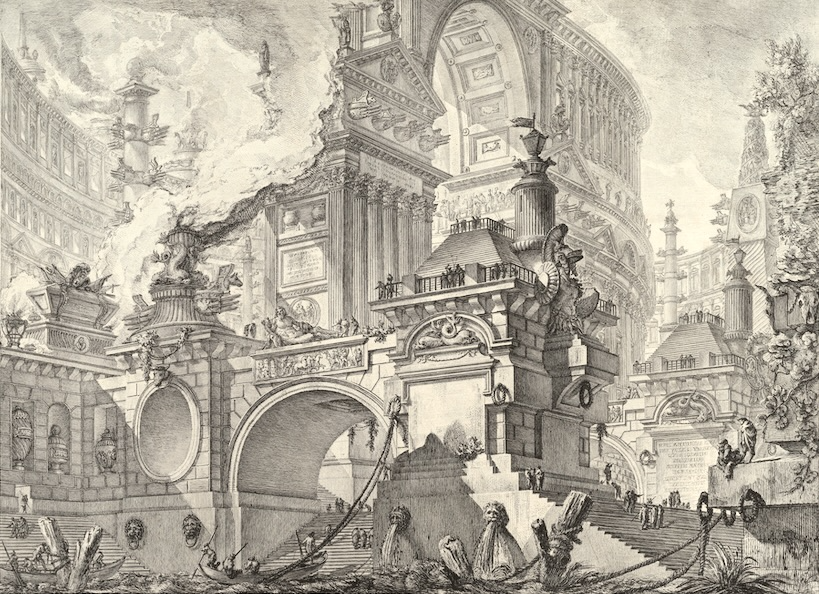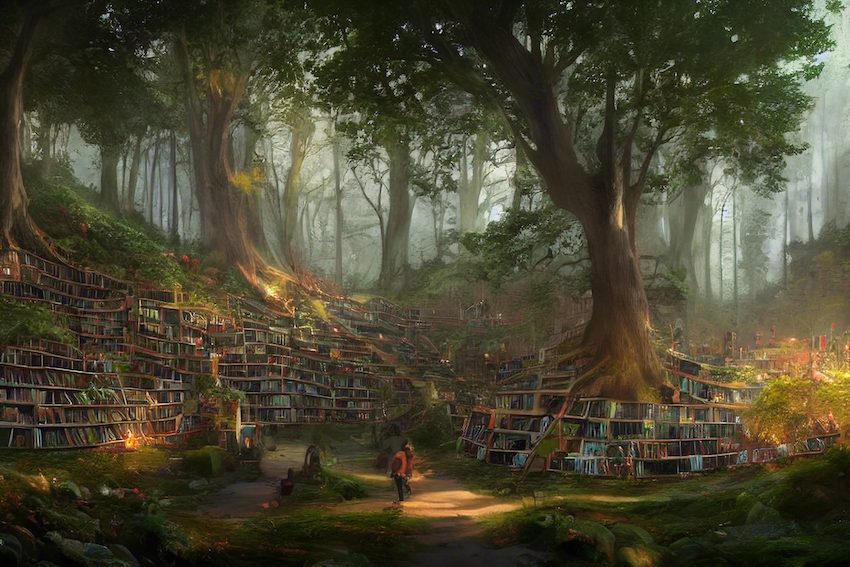October 18, 2022
a spacebar for the web

Piranesi has stayed with me for months. Somewhere at the back of my mind, the tale of a man meandering through an unending labyrinth of vast, waterlogged halls has haunted me.1
He wandered aimlessly through the densely intertwingled network of cavernous halls, each holding mysteries waiting to be unearthed. The solitude of the dense fog was comforting — so many secrets to unravel, so much wisdom to earn. On some days the tides rose, towering waves flooding the halls and tossing him around — his will molded by the whims of forces beyond his control. With nothing but a handful of scribbles on scraps of paper — his memories, like his words faded into blotted splotches in the dampness. The labyrinth was the embodiment of timelessness, the days, the halls, the pages blending into a dizzying blur.
where from? where to?
That’s how I feel living on the internet.
In the early days of writing, spaces didn’t exist.
writinglookedlikethisandwasincrediblydifficulttoreadkindofliketryingtosolveapuzzlewhileridingabikewowimaginereadingawholebooklikethishonestlyimnotevensureyourereadingthisanymoreprobablynotletsjustmoveonlol
The invisible character that shapes this very text had not been invented. Scribes wrote in a style now referred to as scripta continua, in which writing was composed of an unbroken string of characters.
New mediums borrow elements from the ones that precede them. Film started by imitating the theatre, television similarly followed film, the web recreated print, and writing was shaped by the oral tradition. The first writers merely transcribed what they heard — “we don’t insert pauses between each word — long stretches of syllables flow unbroken from our lips.”2 This mode of writing was representative of its time. Early writing was a means to document events, a supplement to the oral tradition, but not a medium in its own right. Often, performers used the writing as cue sheets. The ambiguity of words arising from the lack of spaces and punctuation gave them the freedom to interpret the text as they chose3; however, this made text a less-than-ideal medium for anything more than documentation.
As you’ve probably experienced above, scripta continua placed an extra cognitive load on the readers of the time, requiring all of the reader’s attention to decipher the text, and significantly limiting their capacity to engage with it. Readers read text out loud, partially as a holdover from the oral tradition, but also to make more sense of the impenetrable wall of symbols.
Readers’ eyes had to move slowly and haltingly across the lines of text, pausing frequently and often backing up to the start of a sentence, as their minds struggled to figure out where one word ended and a new one began and what role each word was playing in the meaning of the sentence. Reading was like working out a puzzle. The brain’s entire cortex, including the forward areas associated with problem solving and decision making, would have been buzzing with neural activity.4
Reading like this wasn’t fun. Yet the power of the medium justified its inconveniences. Text molded the mind like no medium before it, allowing us to not only store and retrieve, but formulate and transmit information — it was a literal extension of the mind.
Around the start of the second millennium, as the availability of books expanded, readers began to push against the limits of the medium — they wanted to read more quickly and privately without the burden of reading out loud. Fortunately, text was an open medium. And open-ended mediums evolve; specifically, they evolve new affordances that then shape new behaviors.
Enter, the humble space. And punctuation. And a standardized system of word order.
The floodgates opened, and a whole new set of behaviors burst forth — adding spaces between words, along with the development of syntax freed the mental faculties of the reader allowing them to read faster, comprehend more, and absorb more challenging texts. This gave readers the ability to read deeply, allowing them to engage with the text, wrestling with the ideas — making the material their own. Additionally, reading and writing as a practice were further democratized, literacy increased, and the practice of editing ones work emerged (since it wasn’t highly annoying to reread your writing).5
A simple interface change dramatically improved how we engaged with text as a medium.

An infinite forest of information that we wander through, foraging for ideas, leaving a trail of violet links in our wake.
The browser is the interface for the web. It shapes how we think — both within the confines of the web and without it.
Yet, we’re stuck with basically the same set of interfaces to interact with the web that we had three decades ago. Modern browsers aren’t built to manage thousands of links and ideas — we use a mishmash of bookmarks, tabs, folders, screenshots, extensions, read-it-later apps, highlighters, tab managers, and even shiny new browsers to (not very successfully) manage the overload. But these solutions seem to miss the underlying source of the problem — the very nature of the medium that is the web.
This stems from the structure of the web — it’s a tangle of links, a jumble of interconnected ideas. It fractalizes our attention, nudging us to leave fragments of our mind trapped in open tabs like a thousand tiny horcruxes — open loops feeding off our attention until they wither away, replaced by our latest distraction.
There’s a bottleneck here: our interfaces haven’t evolved to handle the flood of information that’s overflowing our minds. Our interfaces have been feeding us, but don’t allow for any digesting.
How can we use the web as a medium to think, not over months or years, but over a lifetime? How do you create context from an infinitely rotating roster of indistinguishable tabs?
Looking at my browser, it feels eerily similar to the early days of writing. We hardly realize it as we gently trip from link to link, but like the words in scripta continua — there are no spaces between pages on the web. And unlike the rigid spaceless words of the old, we add to our neat row of tabs — increasingly squished together with each additional click — an all too obvious metaphor for our fragmenting attention.
On the web, there’s no room to think, it’s a blur of ideas, a contextless void, devoid of all concept of time and space. Our minds, overflowing with information, lack context — the tools and scaffolding to make sense of it all. It’s not impossible, but it’s draining. And much like deciphering the homogenous blocks of early text, it’s not ideal.
Though invisible, space is what gives form and meaning to what it encloses. It’s in the negative spaces where meaning is created. Living in these spaces is an act of sensemaking, marked with intention — actively directing attention away from the flood, and just being. If we lack space, we lack the means to create context.
It took centuries for writing to evolve the affordances to become a refined medium for thought. We need to develop the paradigms that allow us to do the same with the web. A medium to make sense of it all. A medium that doesn’t scatter our attention with a press, but consolidates it by giving us space to breathe.
We need a spacebar for the web.
This is the first in a series of explorations weaving together the fascinating threads of the web, browsers, and tools for thinking. It’s an experiment in building-in-public and wayfinding through the past, present, and future of the medium. Hope to share more soon!
Thoughts? I’d love to hear them! You can reach me on Twitter or by Email
